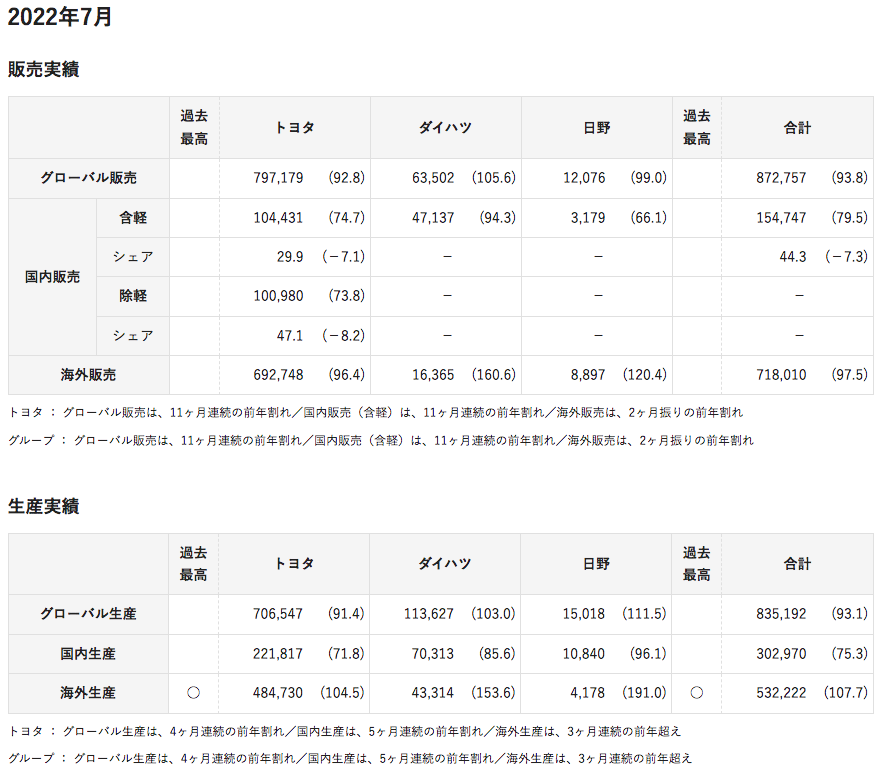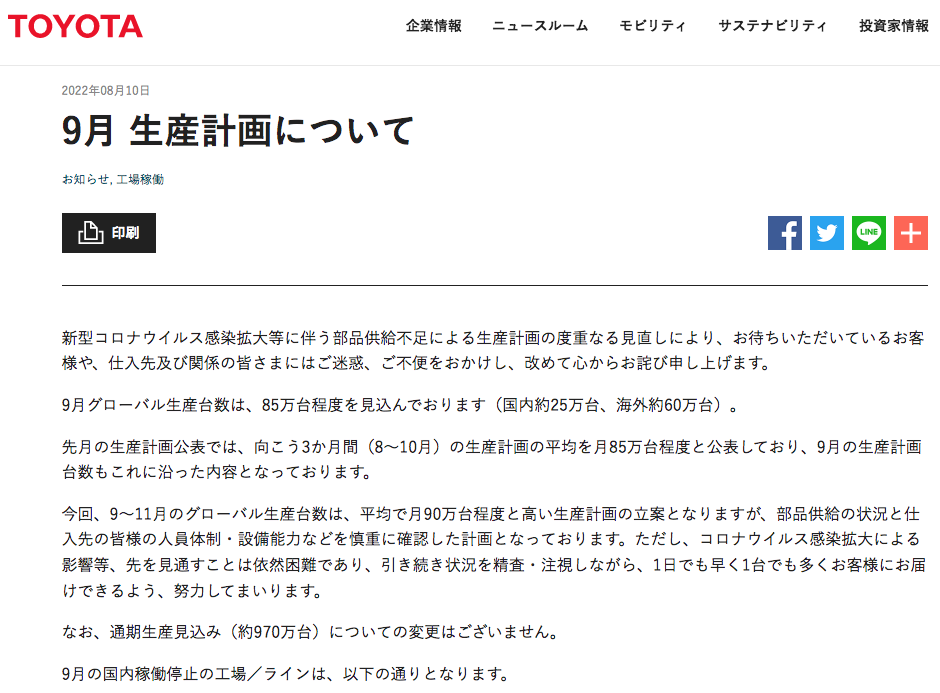In addition to Weibo, there is also WeChat
Please pay attention

WeChat public account
AutoBeta


2024-11-21 Update From: AutoBeta autobeta NAV: AutoBeta > News >
Share
AutoBeta(AutoBeta.net)08/31 Report--
On August 30, Toyota Motor Group released production and sales data for July 2022. Data show that Toyota's global sales fell 7.2% year-on-year to 797179 vehicles in July 2022, falling year-on-year for 11 consecutive months. Sales in Japan fell 25.3% year-on-year to 104431 units, while overseas sales fell 3.6% year-on-year to 692748 units. In terms of output, Toyota's global output fell 8.6% year-on-year to 706547 vehicles in July 2022, lower than the previously expected target of 800,000 vehicles.

From the data point of view, Toyota's overall sales and production in July are not very optimistic. For July production and sales data decline, Toyota said, The reason is due to the epidemic and semiconductor demand increased parts supply shortage, Toyota some factories forced to shut down or reduce production, Affected by this, Toyota sales and production in July are lower than the previous year's level.
Specifically, in terms of output, taking this month as an example, Toyota previously announced that it plans to produce 800,000 vehicles worldwide in July, including 250,000 in Japan and 550,000 overseas. But in fact, Toyota's global production in July was 706547 units, down 8.6% year-on-year, falling for four consecutive months, with Japan's domestic market down 28.2% year-on-year to 221817 units and overseas production up 4.5% year-on-year to 484730 units. Toyota said overseas production rose 4.5 per cent to a record level in July, driven mainly by a strong recovery in Europe, China and the rest of Asia, but production in Japan fell 28.2 per cent.

Within Japan itself, Toyota is affected by uncertainties in addition to supply chain disruptions caused by chip shortages and the new crown pneumonia epidemic. On July 27, Toyota announced that due to the outbreak of Xinguan pneumonia, a production line at Toyota's Takaoka plant was suspended for night shift operation, resulting in a loss of production of about 650 vehicles; On July 28, Toyota announced that it would suspend more production lines in Toyota's home market in Japan due to difficulties in parts procurement caused by heavy rain. Toyota said that Aichi Prefecture in central Japan and other places were affected by heavy rain, making it difficult to purchase auto parts. For this reason, 3 production lines of 2 factories out of 28 production lines in 14 factories in Japan's home market were suspended. Affected by this, Toyota cut domestic production in Japan by about 4000 units in July. On July 29, Toyota Motor said that two factories affected by the rainstorm had resumed normal operation, while two production lines of another factory had extended their shutdown time. The number of vehicles affected by the rainstorm was about 1000, and the cumulative number of vehicles affected by the rainstorm was about 5200. In addition, under the spread of Japan's seventh wave of new crown epidemic, employee infection also affected Toyota's production. At the end of July, Toyota's Japanese factory was forced to suspend production for some periods due to the epidemic, delaying the production of Corolla and other models.

According to the plan, Toyota's annual production plan for fiscal year 2022 (April 2022-March 2023) is about 9.7 million vehicles. According to this calculation, the production capacity in the first four months of this fiscal year (April-July) lags behind by 10.3%. Since entering this fiscal year, Toyota Motor has encountered many shutdown and production reduction problems, and even lowered its production capacity plan three times in a month. Take June as an example. Toyota originally planned production capacity of 950,000 vehicles in June. However, due to the great environmental impact, Toyota adjusted production capacity three times before and after, resulting in only 750,000 vehicles remaining in the final estimated production capacity, with a cumulative production reduction of about 200,000 vehicles. However, Toyota has repeatedly stressed that it will maintain its annual production target of 9.7 million vehicles.
On Aug.10, Toyota Motor announced that according to the original plan, Toyota's average production plan from August to October was 850,000 vehicles per month, given that some months failed to achieve production capacity as scheduled due to the shortage of chips and supply chain disruptions in the first half of this year. To this end, Toyota Motor will increase the September-November average production plan to 900,000 vehicles and maintain the annual production target of 9.7 million vehicles.

However, given Toyota's 10.3% capacity lag in the first four months of the fiscal year (April-July), industry sources pointed out that Toyota's full-year production target may face a downward revision. Seiji Sugiura, senior analyst at Tokai Tokyo Research Institute, said: "Toyota is not out of the woods yet, and uncertainty about chip stability procurement is a risk, so there is doubt that Toyota will stick to its production target of 9.7 million units." Given what happened in the first half of the year, Toyota will probably set production levels at 800,000 or 850,000 vehicles per month, and if it goes above 800,000 vehicles per month, that would be a record."
According to AFS statistics, as of August 28, due to chip shortage this year, the global auto market cumulative production reduction of about 3.123 million vehicles, AFS forecast, by the end of this year, the global auto market cumulative production will increase to 3.962 million vehicles. Honda, which is also a Japanese automaker, recently announced that it faces production cuts due to shortages of semiconductors and other components, the spread of the new crown epidemic and logistics stagnation, with two production lines at its Suzuka plant in western Japan cutting output by about 30% in early September, while its Saitama plant in northern Tokyo will also cut output by about 40% in early September. Overall, Japanese car companies are still suffering from epidemic diseases, semiconductor and raw material shortages, and the low production capacity and sales volume have not been completely improved.
Welcome to subscribe to the WeChat public account "Automotive Industry Focus" to get the first-hand insider information on the automotive industry and talk about things in the automotive circle. Welcome to break the news! WeChat ID autoWechat
Views: 0
*The comments in the above article only represent the author's personal views and do not represent the views and positions of this website. If you have more insights, please feel free to contribute and share.











© 2024 AutoBeta.Net Tiger Media Company. All rights reserved.